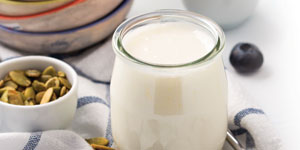Food
3 min Read
Ask a dietitian: Should I be opting for whole milk and other full-fat dairy products for my family?

December 7, 2016
Food
3 min Read

December 7, 2016


I’ve heard that saturated fat is not as unhealthy as was previously thought. I had been buying 1% milk but should I be opting for whole milk and other full-fat dairy products for my family?
You’re not alone in your confusion. Many media reports would have you believing that higher fat dairy products are a healthier choice. For children two and under, whole dairy milk is definitely recommended but for the rest of us, youngsters included, eating less saturated fat is still advised.
For many years, saturated fat was thought to be dietary demon number one. But then scientists compared replacing these fats with sugar and refined carbohydrate selections such as white bread. They found that decreasing the saturated fat and eating sugary options instead didn’t supply any advantages to health. But while research shows it’s less harmful than previously thought, it doesn’t offer any health benefits. So just because something isn’t as bad for you, it doesn’t make it healthy either.
Recent studies show that when you compare saturated fat to the unsaturated fat found in foods such as extra virgin olive oil, canola oil, nuts and seeds and fish, the latter is a clear winner. Unsaturated fats are linked to a whole range of perks including a lower risk of heart disease and diabetes, to name a few.
There is research, though, linking whole milk or full-fat dairy products to protection against weight gain and obesity. Study subjects who consumed higher fat products were less likely to gain weight, but the effect is not due to dairy fat itself. It’s because of the impact of fat itself on satiety. Low fat diets, unless packed with plenty of fibre, aren’t very satisfying and can lead to overeating.
Rather than drinking whole milk or eating full-fat cheese all the time, consuming lower fat dairy products along with healthy fats boosts the nutrition ratings significantly. Not only are the same number of calories consumed but it’s also satisfying. For example, instead of a serving of whole milk yogurt, a lower-fat one with some nuts or seeds (pumpkin or sunflower for those with nuts allergies) provides the nutrients from dairy along with healthy fats from the nuts and seeds.
That’s not to say there’s no room for butter and full-fat cheeses. Moderation is key here.
When choosing lower fat dairy products, in terms of taste, not all are created equal. Fat-free cheeses, for example, can be rubbery and tasteless. But a part-skim milk cheese, especially when teamed up with tasty partners, can be palate-pleasing. A whole grain English muffin topped with a zesty tomato sauce and part-skim mozzarella is a terrific breakfast or lunch option. Another way to up the taste quotient in cooking dishes, such as macaroni and cheese, is to use some lower-fat cheese with a small amount of a flavourful higher fat one.
For milk and yogurt, look for those with 1% or 2% M.F. on the label. They will supply about two and four grams of fat respectively per cup compared to eight grams for whole milk. Cheese labelled in the 15% to 20% range would correspond to the 1% and 2% milk.
Rosie Schwartz is a consulting dietitian in private practice in Toronto and author of The Enlightened Eater’s Whole Foods Guide (Viking Canada). Read more at rosieschwartz.com.
Originally published in ParentsCanada magazine, Nov/Dec 2016.